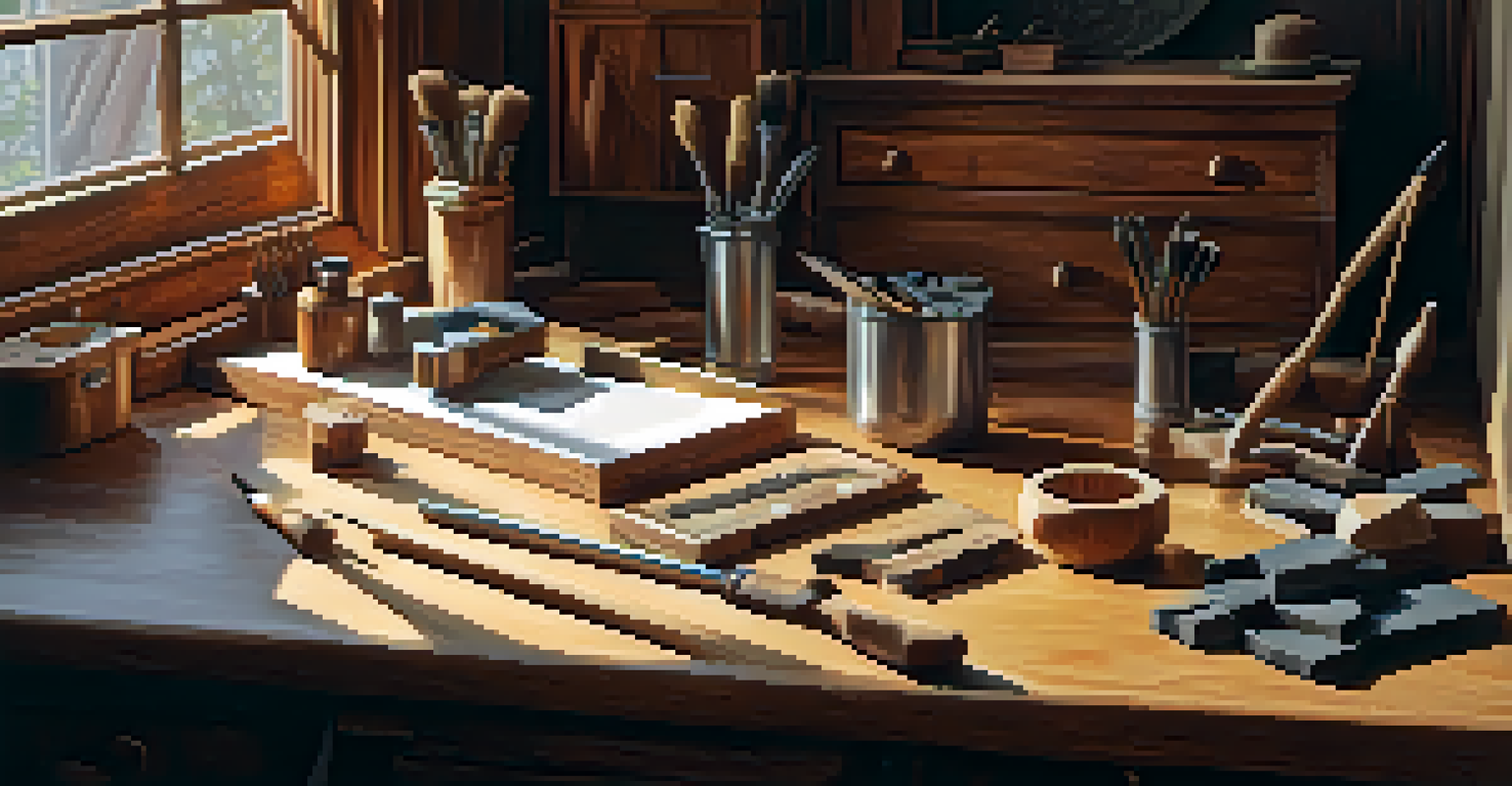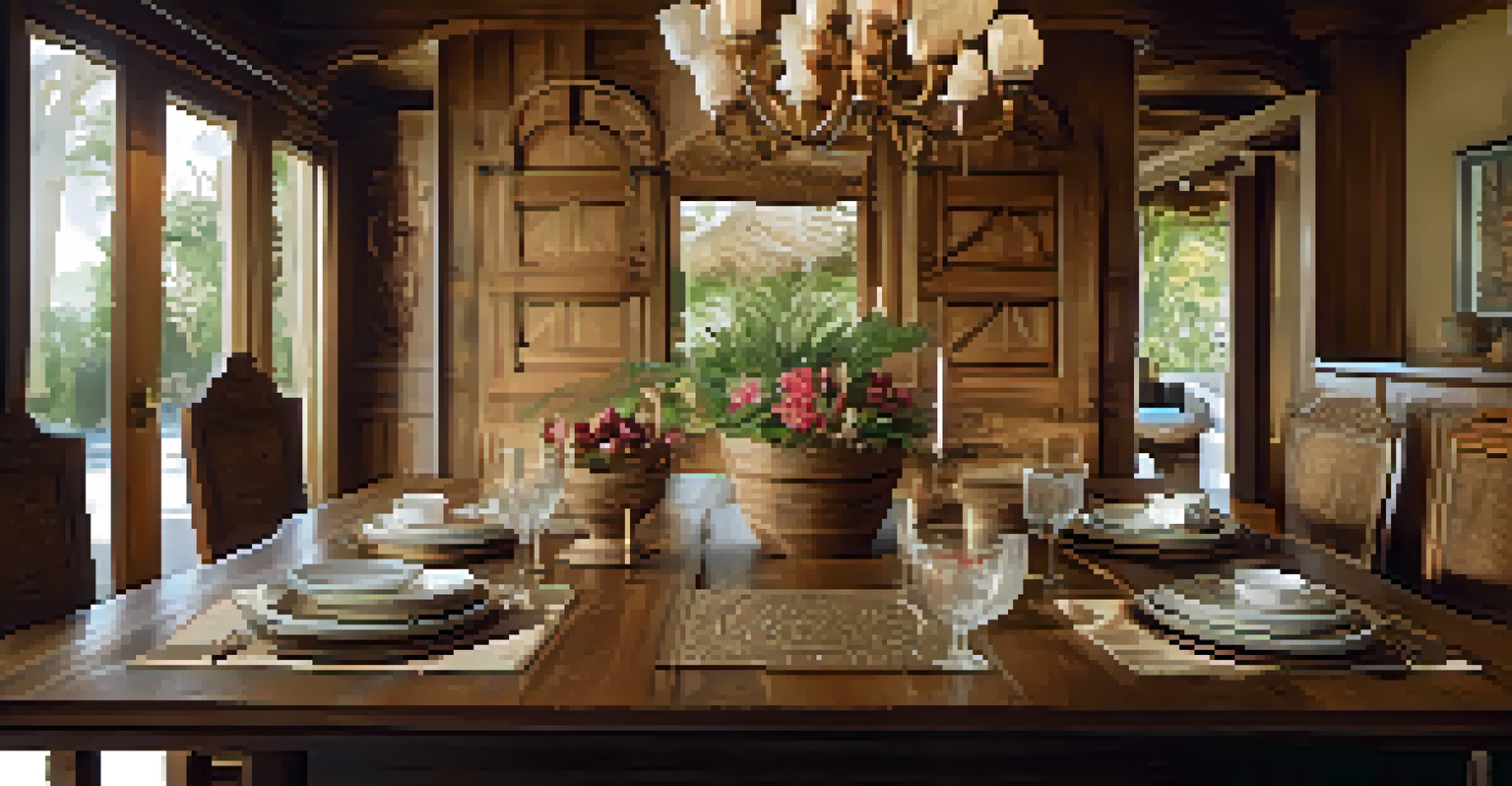Step-by-Step Guide to Carving Designs in Furniture Pieces

Understanding the Basics of Furniture Carving
Before diving into furniture carving, it's crucial to understand the basics. Carving is the art of shaping wood with tools to create beautiful patterns and designs. This not only enhances the aesthetic of your furniture but also adds a personal touch that reflects your style.
The beauty of wood carving is that you can create something that reflects your personality and style.
Familiarizing yourself with different types of wood can significantly impact your carving experience. Hardwoods like oak or cherry are often preferred for their durability and fine grain, while softer woods like pine are easier for beginners. Knowing your material helps in choosing the right tools and techniques.
Lastly, consider the design you want to carve. Some designs are intricate and require advanced skills, while others are simpler and great for beginners. Sketch your design beforehand to visualize how it will look on the furniture piece.
Gathering the Right Tools for Your Project
Having the right tools can make a world of difference in your carving journey. Essential tools include carving knives, chisels, and gouges, each serving a unique purpose. For instance, chisels are excellent for making precise cuts, while gouges help in shaping curves.

Don’t forget about safety gear! Protective eyewear and gloves are important to keep you safe while working. Remember, carving can create wood shavings and dust, so a mask can also be a good idea to protect your lungs.
Basics of Furniture Carving
Understanding the types of wood and design choices is essential for a successful carving project.
Lastly, consider investing in a sturdy workbench or a clamp for stability. A secure workspace allows you to focus on your carving without worrying about the furniture piece moving around.
Preparing Your Furniture Piece for Carving
Preparation is key before you start carving. Begin by sanding your furniture piece to create a smooth surface, free of any rough spots or imperfections. This not only makes it easier to carve but also helps the design stand out once finished.
Every piece of wood has a story; it's up to you to uncover it through your carving.
Next, draw your design on the surface using a pencil or a light-colored chalk. This sketch serves as a guide, ensuring you stay on track as you carve. Don't worry if it's not perfect; you can always adjust as you go.
Finally, make sure your furniture is securely positioned. Use clamps to hold it in place on your workbench, preventing any movement while you’re carving. A stable piece allows for more precision and gives you better control over your tools.
Starting with Simple Designs to Build Confidence
As a beginner, it's wise to start with simple designs that boost your confidence. Basic shapes like lines, circles, or floral motifs are excellent for practice. These designs help you get comfortable with your tools and the carving process without feeling overwhelmed.
Once you’ve mastered the simple shapes, gradually incorporate more complex designs. For instance, start with a basic flower and then add details like leaves or stems. This step-by-step approach allows you to build your skills steadily.
Essential Tools for Carving
Having the right tools and safety gear significantly enhances your carving experience and ensures safety.
Remember, practice makes perfect! Don’t be discouraged by mistakes; they are part of the learning experience. Each carving project enhances your skills, making you more proficient over time.
Mastering the Techniques of Wood Carving
Understanding different carving techniques is essential to creating unique designs. For example, relief carving involves carving away the background, leaving the design raised. This technique adds depth and texture, making your furniture piece stand out.
Another popular technique is chip carving, where small chips of wood are removed to create patterns. This style is particularly effective for decorative elements on tabletops or drawer fronts. Experimenting with various techniques will help you find your personal style.
Don’t forget about the finishing touches! Techniques like sanding, staining, or sealing your carved designs can enhance their appearance and protect the wood. A well-finished piece not only looks beautiful but also lasts longer.
Incorporating Carving into Different Furniture Styles
Carving can elevate various furniture styles, from rustic to modern. For instance, traditional styles often feature intricate carvings depicting natural elements like flowers or leaves. These designs add a touch of elegance and craftsmanship.
Conversely, modern furniture may benefit from minimalistic carvings that focus on geometric shapes or clean lines. This approach allows for a contemporary feel while still showcasing your unique flair.
Caring for Carved Furniture
Regular maintenance and proper placement are key to preserving the beauty and longevity of your carved furniture.
Think about the overall theme of your home when incorporating carving into your furniture. Whether you prefer classic or modern designs, ensure that your carved elements complement your existing decor.
Maintaining and Caring for Your Carved Furniture
Once you've created your masterpiece, proper maintenance is essential to keep it looking its best. Regular dusting with a soft cloth helps prevent dirt buildup, which can dull the appearance of your carving. Additionally, avoid using harsh chemicals that may damage the finish.
Consider applying a wood conditioner or polish occasionally to enhance the natural shine of the wood. This not only keeps your carved details vibrant but also protects the wood from drying out over time.

Lastly, be mindful of the furniture's placement. Avoid exposing it to direct sunlight or extreme humidity, as these conditions can warp the wood. Proper care ensures your carved furniture remains a stunning centerpiece for years to come.